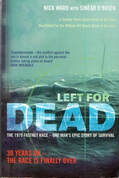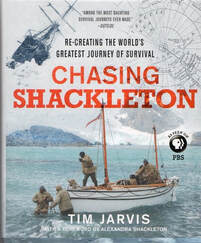All the books featured on this page can be borrowed from the DCA Library or purchased new or secondhand from online booksellers.
Learning about dinghy cruising
The Dinghy Cruising Companion by Roger Barnes 2nd Edition published in 2022
|
This guide, written by the DCA President, is essential reading for all aspiring or already-enthusiastic dinghy cruisers. It shows how to get started and how to expand your horizons. The information and advice is interwoven with wonderfully evocative stories of the author's adventures afloat, from idyllic weeks pottering around secluded rivers and coastlines to hair-raising voyages to remote islands.
Topics include:
|
In this new edition of Roger's book he tells the story of his first capsize and includes new material on electronics, clothing and boat designs. It also benefits from a bigger format and clearer text.
|
Practical Dinghy Cruiser by Paul Constantine
This book, written by DCA member Paul Constantine, begins by asking Who Cruises? and What is Dinghy Cruising? The next question is Can I do it? It goes on to recommend ways of finding out more and asks the reader what kind of dinghy cruising they might like if they were to take it up, for there are many ways to dinghy cruise. The book moves on to a discussion of the different styles of craft, the way each one works and how to evaluate one against the another. The author then explains how he set up his boat for dinghy cruising: the sleeping arrangements, the cooking system, engines and propulsion, the equipment he gathered together and the modifications he made. Throughout the book there are many references to the DCA's articles that further expand the relevant information and add the experiences of numerous different people, in different boats, in different locations. The book acts as a guide to accessing this DCA information. You can borrow this book from the DCA Library or purchase it here. |
Other books to consider when learning to dinghy cruise... all are available to borrow from the DCA Library
If you are seeking inspiration or drama...
|
More than a how-to guide to designing, making, repairing and improving sails, The Sailmaker's Apprentice combines 700 detailed drawings with a witty, wise, and philosophically probing commentary that is as much about living a life of self-reliance and harmony as it is about making sails. Here you will find a visual feast for the sailor as well as an indispensable guide for the mariner. An Amazon reviewer writes: "What a valuable book this is for anyone interested in sailing and sails. It is very informative, clear and readable. From the design of sails and how they were devised using, for example, how the shape of birds' wings make them fly, to all the materials and methods used for top class sail making. It explains how the early apprentices learned their trade by making their own bag using all the basic techniques of sailmaking and repair (see diagram in DC250 p.68) and goes on to choosing materials and designing your own sails." |
|
Some 620 pages in length, This Thing of Darkness is a is an epic novel of sea-faring adventure set in the 19th century charting the life of Robert Fitzroy, the captain of `The Beagle` and his passenger Charles Darwin. It combines adventure, emotion, ideas, humour and tragedy, as well as illuminating the history of the 19th century. Fitzroy, the Christian Tory aristocrat, believed in the sanctity of the individual, but his beliefs destroyed his career and he eventually committed suicide. Darwin, the liberal minor cleric doubts the truth of the Bible and develops his theory of evolution , going on to lasting fame. Despite the apparent tragedy of Fitzroy's life, he was responsible for inaugurating modern weather forecasting methods, as well as the brilliant job he did surveying the South American coast.
Harry Thompson died in 2005, the year the book was published and also long listed for the Man Booker prize. |
|
Peter Clutterbuck is an outstanding dinghy cruising skipper. He started sailing Wayfarer #265 when he was 14 and joined the DCA when he was 16. On July 27 1966 he attempted a cruise along the South Coast with a school friend, which was aborted late in the trip due to bad weather, dangerous seas and major gear failure. He wrote up the log for the DCA Bulletin and it won the Naylor Noggin — in his first year as a DCA member! He completed the cruise from Keyhaven to Weymouth later that year and wrote it up as Part II for the DCA. The UK Wayfarer Association inspected his logs and gave him the Viking Longship Trophy which was first won by Frank Dye. Later, as he approached the age of 18, Peter sailed across the Channel and down to Marseille, via Bordeaux, Toulouse and Sète, achieving the longest voyage made by a class dinghy to that date, for which he was once more awarded the Viking Longship Trophy. These adventures and many more are described in Part One of this book, with plenty of advice given along the way, and in Part Two he passes on his fund of experience. Peter’s DCA membership was cut short by his career, but his truly adventurous sailing wasn't, as you will see if you read his book: it is well written, exciting and informative.
|
|
Tony Smith, aka 'Creeksailor', in Sea Country gives good advice on ditch-crawling. Particularly the use of a marked, 6ft, garden, bamboo cane for rapidly taking soundings in shallow water. He sails all the way up narrow creeks in his 16ft cabin cruiser Shoal Waters., which he inherited from DCA member Charles Stock. The book covers Suffolk, Essex, the Thames and Kent. He has written another book which focuses entirely on the River Blackwater. Click here to read a review of Sea Country by Keith Muscott (from DC 224 p. 58) |
|
Geoff Stewart describes his adventure sailing from Gibraltar to the Canaries, Barbados, St Vincent and Jamaica in a 22 foot open boat (it was a Drascombe Longboat) in Sail South...till the butter melts. He says 'I needed navigational advice from a lightship while crossing the English Channel, had trouble finding the Canary Islands, but hit Barbados on the nose at the end of a 3000 mile 'Columbus' style crossing.' He explains that 'Sail south till the butter melts, and then due west' is the frolicsome version of the sailing directions for crossing the Atlantic. It is a great read, written in cruising log style with poetic interludes. |
|
Another small boat odyssey is described by A J Mackinnon in The Unlikely Voyage of Jack de Crow. He takes his Mirror dinghy from the borders of North Wales to the Black Sea - 4,900 km over salt and fresh water, under sail, oars or at the end of a tow rope - through twelve countries, 282 locks, and numerous trials and adventures, including an encounter with Balkan pirates. Loaded with self-deprecating humour and one giddy adventure after another, this account of Mackinnon's voyage is perfect for armchair voyagers. It is not a book to be used as a guide to dinghy cruising! |
|
Ted Jones was a much-loved sailor who was totally dedicated to the DCA, and in his time to other clubs, too. His tales appeared regularly in our journal. His son Ben (also DCA) has produced a limited run of a beautifully-bound anthology of his stories, written originally for the Mirror, Sunspot and Dinghy Cruising Associations — Sailing Yarns. The stories cover a lifetime of sailing dinghies, catamarans and small cabin boats around the UK, but mainly on the East Coast. They include many unusual experiences, sometimes bordering on the surreal, such as his boat being covered by thousands of migrating Red Admiral and Large White butterflies just as he was negotiating the Deben entrance. Very well written with adventures that will call to mind all your own adventures. And disasters.
Read Ted's last cruise report, which was published in DC 209 by clicking here. |
|
The 1979 Fastnet race disaster fascinates still. Fifteen died. Rousmaniere's Fastnet Force 10 is a clinical report of events and of the largest air sea rescue since WWII. This was a catastrophe that changed yachting forever. Left for Dead by Nick Ward includes an epilogue 30yrs after he was left on a flooded, dismasted Fastnet yacht with a dead companion. It is a more personal, searing story of survival. But it also sets out the changes introduced after the event. |
|
Chasing Shackleton and In Shackleton's Wake are modern replica voyages of Shackleton's 800 mile Southern Ocean passage in the 23ft James Caird. Followed by crossing the South Georgia ice cap. Illuminating and, for armchair sailors, inspiring. Members will find a full review of Arved Fuchs book in Dinghy Cruising 245. |
|
Ben Crawshaw's Catalan Castaway (2013) is presented in an attractive unconventional format, profusely illustrated, and tells the story of how he built Gavin Atkin's fair-weather design the 15ft two-masted Light Trow, then proceeded to sail it adventurously off the Spanish Coast and further into the Mediterranean Sea, to the barely concealed alarm of its designer. A story made poignant by the young sailor battling with 'the giant octopus' of life-threatening disease when he was well advanced in his adventures and enjoying every minute of them — and demonstrating that 'the dream is nearer to our grasp than we think'.
Click here to read reviews of this book by Paul Constantine and Keith Muscott (from DC 223 pp.44-45) |
The friendly club with a sense of adventure. For all sailors who use boats for more than just racing.
|
© 2010-2024 DCA. All Rights Reserved. |
|























